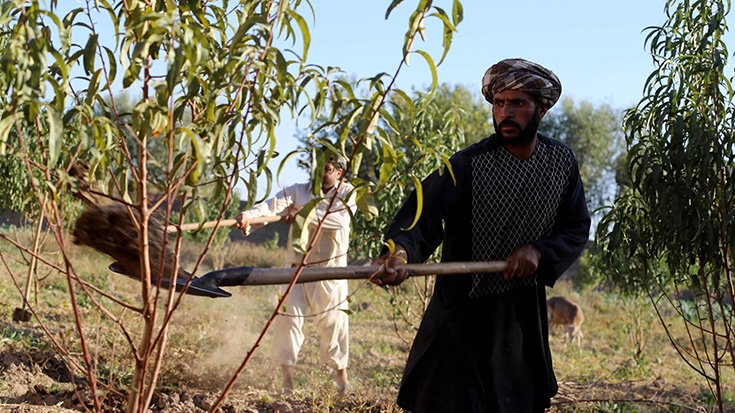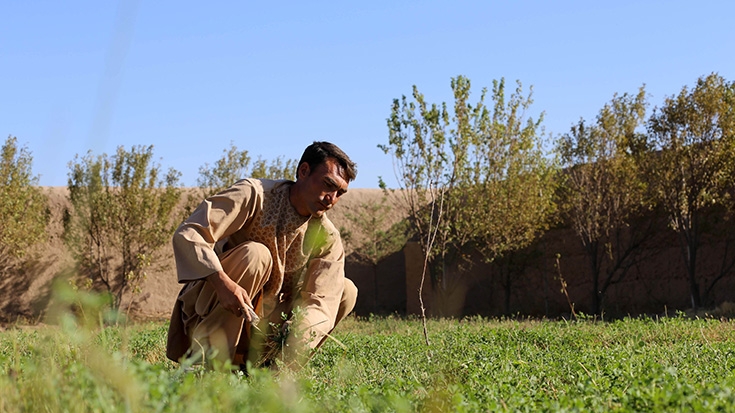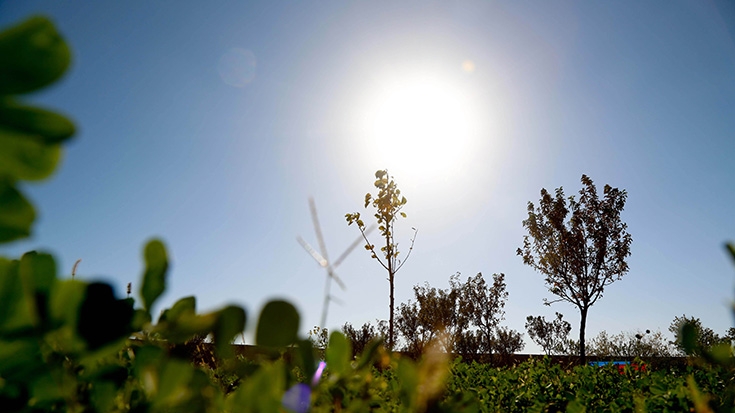“I have different kinds of fruits here. I used to frequently need to re-plant them, and there was no one to educate me that I should observe the minimum distance of 5 meters between plants, and our production was almost zero,” says Gul Ahmad.
“Now we know we are supposed to plant 66 saplings in one jerib (one-fifth hectare) of land. This way both the harvest and the lifespan of the plants will improve and these 66 plants will yield as much as 200 poorly managed plants would!”
The NHLP, implemented by the Ministry of Agriculture, Irrigation and Livestock (MAIL) with support from the Afghanistan Reconstruction Trust Fund (ARTF), contributes to the overarching goal of increased productivity and overall production of horticultural products, and improved animal production and health.
The technical strategy for achieving this objective is based on the delivery of extension and investment support through strengthened systems. The project has three components: (i) Horticultural Production; (ii) Animal Production and Health; and (iii) Implementation Management and Technical Assistance Support. These activities are currently implemented in 140 districts in 21 target provinces, numbers that may grow as conditions warrant.
Sarajuddin, a young farmer who works with Gul Ahmad, also expresses satisfaction with the trainings he has received. “Since we inherited this activity and did not know much about agriculture, we did not generate much income. Our plants would only yield every other year and there was no one to teach us the right way of doing our job.”
NHLP promotes best practices
“One way or another, we contribute to farmers’ achievements, income and opportunities,” says Besmillah Royan, NHLP marketing officer for western Herat Province. “Moreover, we provide them with tools such as trimmers or pruners, produce collection baskets and so on, plus we support their efforts in standardized product packaging. Overall, the goal is to enable supply of commercial market grade products.”
Agriculture is considered the main source of income for rural Afghans. NHLP aims to improve the lives of the rural majority by promoting best practices for increased productivity and higher quality in horticulture.
To date, NHLP has financed the establishment of 5,229 hectares of new orchards (against a target of 2,000 hectares), of which 32 percent are in new provinces. Similar substantial achievement has been recorded for rehabilitation of orchards (29,192 hectares actual against a target of 2,000 hectares). In western Herat Province, 186 model orchards have been established so far, 129 of which are located in Enjil district and another 57 in Gozara district.
Training brings hope for better life
Faiz Ahmad, a resident of Naween-e Bala village of Enjil district, is another beneficiary of NHLP. Father of eight children, four of whom are attending school, Faiz Ahmad has been a famer since childhood.
“Agriculture is a nice activity but my children should be literate as well because an illiterate person will not go too far in life” observes Faiz. “I am illiterate and probably my illiteracy has barred me from gaining more knowledge of agriculture and making more progress in life. Whatever I earn is spent on subsistence for my family of 10. We do not have any savings because we have never routinely had abundant harvests.”
Faiz is convinced that, due to the guidance by NHLP personnel, he has seen an unprecedented change in his work: “They came this year and provided us training and access to good saplings for planting. Previously we were inexperienced and our saplings would not grow well, but now you can see how well our plants have grown and are continuing to grow bigger and stronger. It was them (NHLP staff) who educated us on how to plant, how to trim and so forth.”
Faiz Ahmad believes that with implementation of NHLP in his village, the farmers will see a 60 - 70 percent increase in their production. “Had we been as knowledgeable in this activity as we are now after completing these trainings, we would have applied these practices from the beginning. In that case, there would be no need to import fruit from Iran or Pakistan; rather, we would be exporting fruit to these countries,” he concludes.



